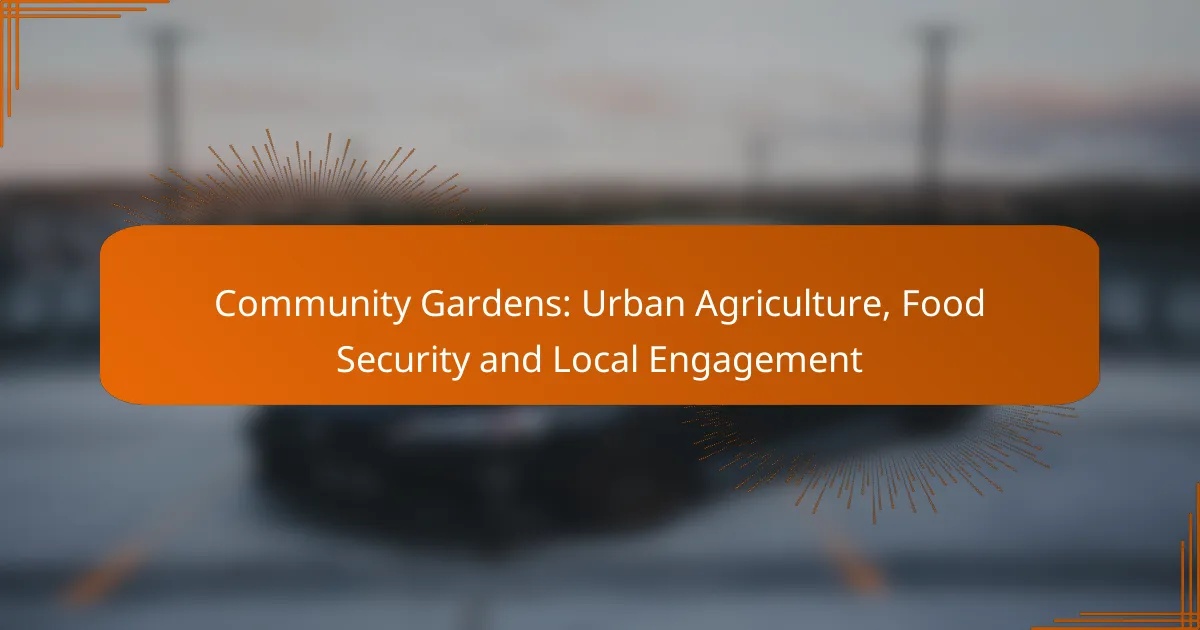Community gardens play a crucial role in urban agriculture by offering accessible spaces for food production, which fosters community engagement and enhances food security. These gardens empower residents to grow their own fresh produce, contributing to healthier diets and stronger social connections. Additionally, they serve as essential resources in urban areas where access to affordable grocery options may be limited.
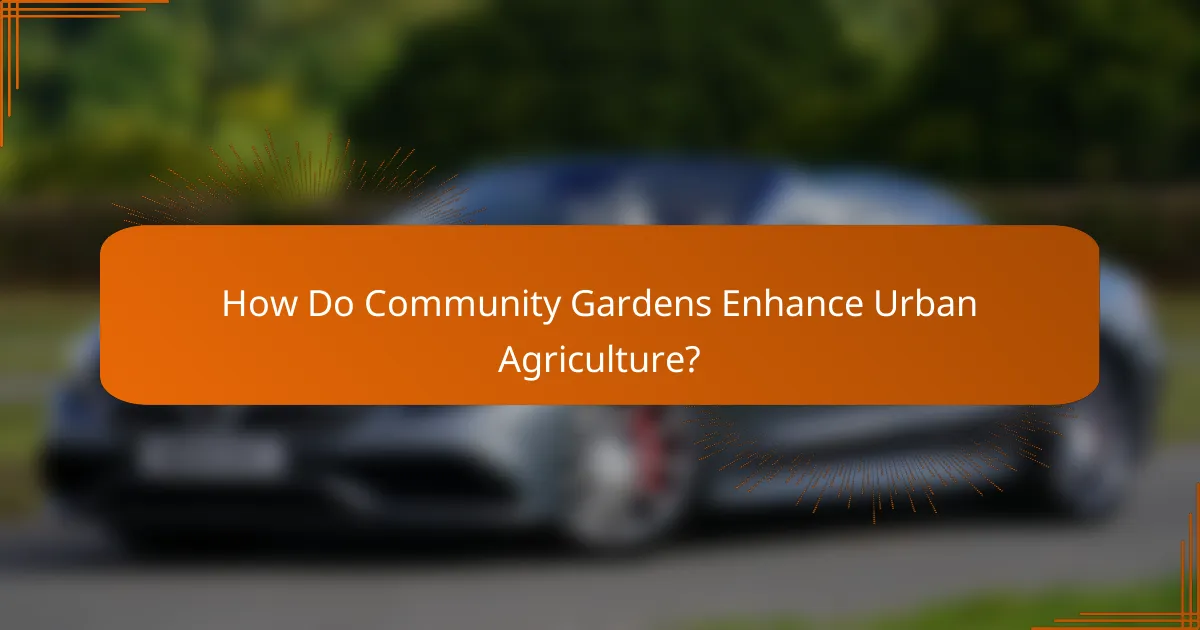
How Do Community Gardens Enhance Urban Agriculture?
Community gardens significantly boost urban agriculture by providing accessible spaces for local food production, fostering community engagement, and enhancing food security. These gardens create opportunities for residents to grow their own food, which can lead to healthier diets and stronger community ties.
Increased local food production
Community gardens directly contribute to local food production by transforming underutilized spaces into productive areas for growing fruits and vegetables. Residents can cultivate a variety of crops, often resulting in a diverse harvest that meets local needs.
By growing food locally, community gardens reduce reliance on imported produce, which can lower costs and minimize carbon footprints. This is particularly beneficial in urban areas where access to fresh food may be limited.
Promotion of biodiversity
Community gardens promote biodiversity by encouraging the cultivation of various plant species, including native and heirloom varieties. This diversity supports local ecosystems and can attract beneficial insects, such as pollinators.
Incorporating a range of plants not only enhances the garden’s resilience to pests and diseases but also creates habitats for wildlife, contributing to a healthier urban environment.
Utilization of vacant land
Vacant land in urban areas often presents challenges, but community gardens can effectively repurpose these spaces. By transforming neglected lots into vibrant gardens, communities can improve aesthetics and reduce crime rates associated with abandoned properties.
Utilizing vacant land for gardening also addresses food deserts, providing residents with access to fresh produce where it may otherwise be scarce.
Support for sustainable practices
Community gardens often embrace sustainable agricultural practices, such as organic gardening, composting, and water conservation techniques. These practices not only enhance soil health but also promote environmental stewardship among participants.
By educating community members about sustainable methods, gardens can foster a culture of environmental responsibility, encouraging residents to adopt similar practices in their own homes.
Community resilience building
Community gardens play a crucial role in building resilience by fostering social connections and collaboration among residents. These gardens serve as gathering places where individuals can share knowledge, resources, and support.
Through collective efforts in gardening, communities can strengthen their ability to respond to challenges, such as food insecurity or economic downturns, ultimately leading to a more cohesive and empowered population.
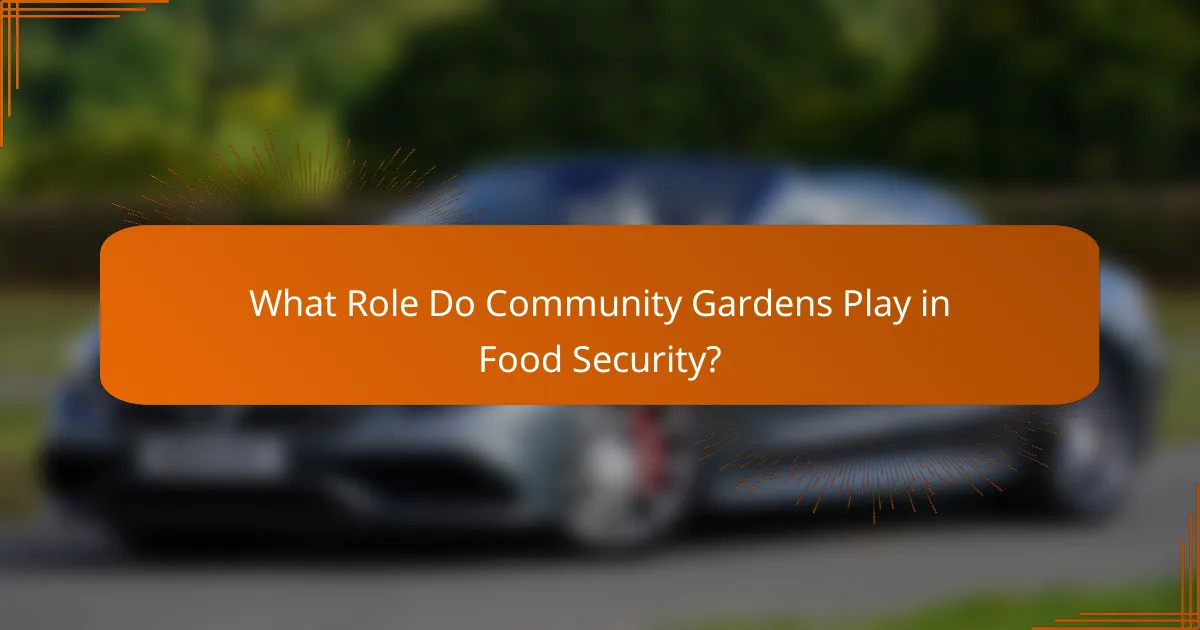
What Role Do Community Gardens Play in Food Security?
Community gardens significantly enhance food security by providing local access to fresh, nutritious produce. They serve as vital resources for urban populations, particularly in areas where grocery stores may be scarce or expensive.
Access to fresh produce
Community gardens offer residents direct access to fresh fruits and vegetables, which can improve overall diet quality. By growing their own food, individuals can enjoy seasonal produce that is often more flavorful and nutritious than store-bought options.
These gardens can help reduce food costs, allowing families to save money while increasing their intake of healthy foods. For example, a small garden can yield several pounds of produce each season, which can significantly supplement a household’s grocery budget.
Reduction of food deserts
Community gardens play a crucial role in mitigating food deserts, areas with limited access to affordable and nutritious food. By transforming vacant lots into productive gardens, communities can create local food sources that are easily accessible to residents.
These initiatives not only provide food but also foster community engagement and collaboration, as neighbors come together to cultivate and maintain the gardens. This collective effort can lead to improved local food systems and greater food equity.
Empowerment through self-sufficiency
Community gardens empower individuals by promoting self-sufficiency in food production. Participants learn valuable gardening skills that enable them to grow their own food, reducing reliance on external food sources.
This sense of empowerment can lead to increased confidence and community pride, as individuals take ownership of their food supply. Additionally, growing food can inspire others to adopt sustainable practices, further enhancing community resilience.
Education on nutrition
Community gardens serve as educational platforms where individuals can learn about nutrition and healthy eating habits. Workshops and events often accompany these gardens, teaching participants how to prepare and incorporate fresh produce into their diets.
By engaging with the garden, people can gain practical knowledge about food systems, including the benefits of eating locally and seasonally. This education can foster healthier lifestyle choices, benefiting both individuals and the wider community.

How Can Local Engagement Be Fostered Through Community Gardens?
Local engagement in community gardens can be fostered through various initiatives that encourage participation and collaboration among residents. By creating opportunities for hands-on involvement, educational events, and partnerships with local organizations, community gardens can strengthen social ties and enhance food security.
Volunteer opportunities
Community gardens thrive on volunteer support, which can range from planting and maintaining garden beds to organizing community events. Residents can contribute their time on a regular basis or during special volunteer days, fostering a sense of ownership and pride in the garden. Many gardens also offer incentives, such as free produce or gardening workshops, to encourage participation.
To maximize volunteer engagement, gardens should clearly communicate their needs and provide flexible schedules. Utilizing social media and local bulletin boards can effectively reach potential volunteers and keep them informed about upcoming opportunities.
Workshops and events
Hosting workshops and events is a powerful way to engage the community in learning and sharing knowledge about gardening, nutrition, and sustainability. These events can include cooking demonstrations, seed swaps, or seasonal festivals that celebrate the harvest. Such gatherings not only educate participants but also create a fun atmosphere that encourages social interaction.
Consider offering workshops tailored to different skill levels, from beginner to advanced. This inclusivity can attract a diverse group of participants, enhancing community involvement and fostering a culture of learning.
Collaboration with local organizations
Partnering with local organizations, such as schools, non-profits, and businesses, can amplify the impact of community gardens. These collaborations can provide resources, funding, and expertise, making it easier to implement programs that benefit the entire community. For example, a local school might use the garden as an outdoor classroom, while a nearby health organization could host nutrition workshops.
When forming partnerships, it is essential to align goals and ensure mutual benefits. Regular communication and shared planning can help maintain strong relationships and maximize the effectiveness of collaborative efforts.
Building social networks
Community gardens serve as a hub for building social networks among residents. By bringing together individuals from diverse backgrounds, gardens can facilitate connections that extend beyond gardening. Regular gatherings, such as potlucks or workdays, can help foster friendships and a sense of belonging.
Encouraging members to share their stories and experiences can deepen these connections. Creating a community bulletin board or an online group can provide a platform for sharing resources, organizing events, and celebrating successes, further strengthening the social fabric of the neighborhood.
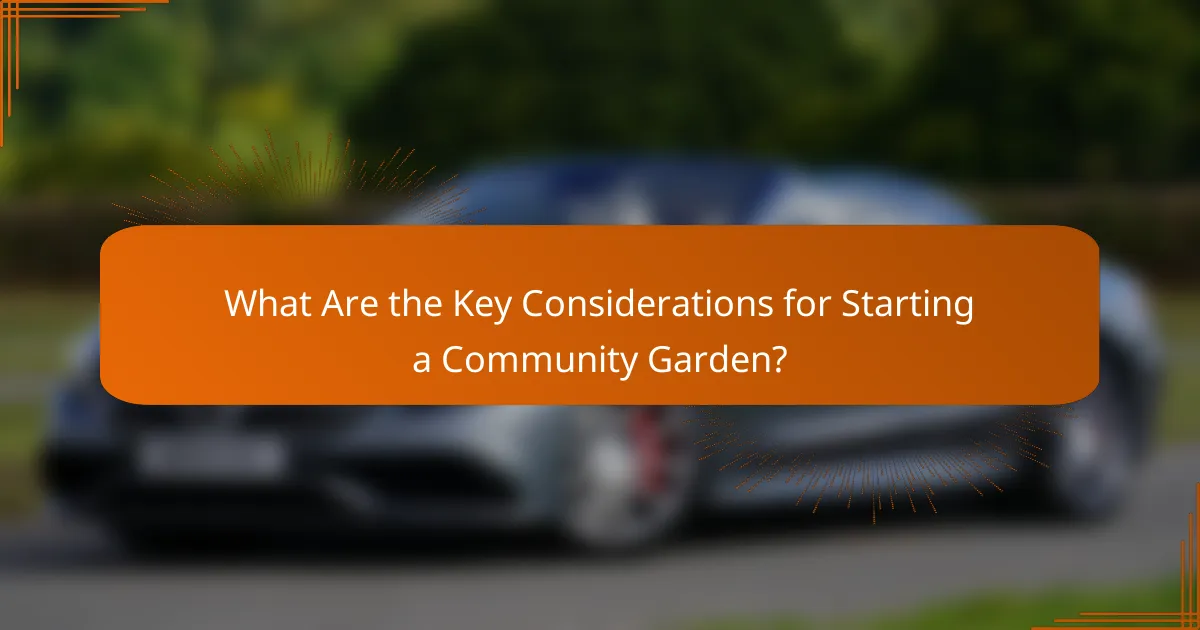
What Are the Key Considerations for Starting a Community Garden?
Starting a community garden involves several key considerations that can significantly impact its success. These include choosing the right site, understanding legal and zoning requirements, and securing funding and resources.
Site selection criteria
Choosing the right site for a community garden is crucial. Look for locations with ample sunlight, access to water, and good soil quality. Proximity to the community you aim to serve is also important to encourage participation.
Consider the size of the site; it should be large enough to accommodate various gardening activities and allow for future expansion. Accessibility for all community members, including those with disabilities, should also be a priority.
Legal and zoning requirements
Before starting a community garden, familiarize yourself with local legal and zoning regulations. Many areas require permits for gardening activities, especially if the land is publicly owned. Check with local government offices to understand any restrictions or requirements.
It’s also important to consider liability issues. Some communities may require insurance to protect against accidents or damage. Engaging with local authorities early can help navigate these legalities effectively.
Funding and resource acquisition
Securing funding and resources is essential for establishing a community garden. Look for grants from local governments, non-profits, or agricultural organizations that support urban agriculture initiatives. Crowdfunding and community fundraising events can also be effective.
In addition to financial support, consider in-kind donations of materials such as soil, seeds, and tools from local businesses. Building partnerships with local gardening clubs or environmental organizations can also provide valuable resources and expertise.
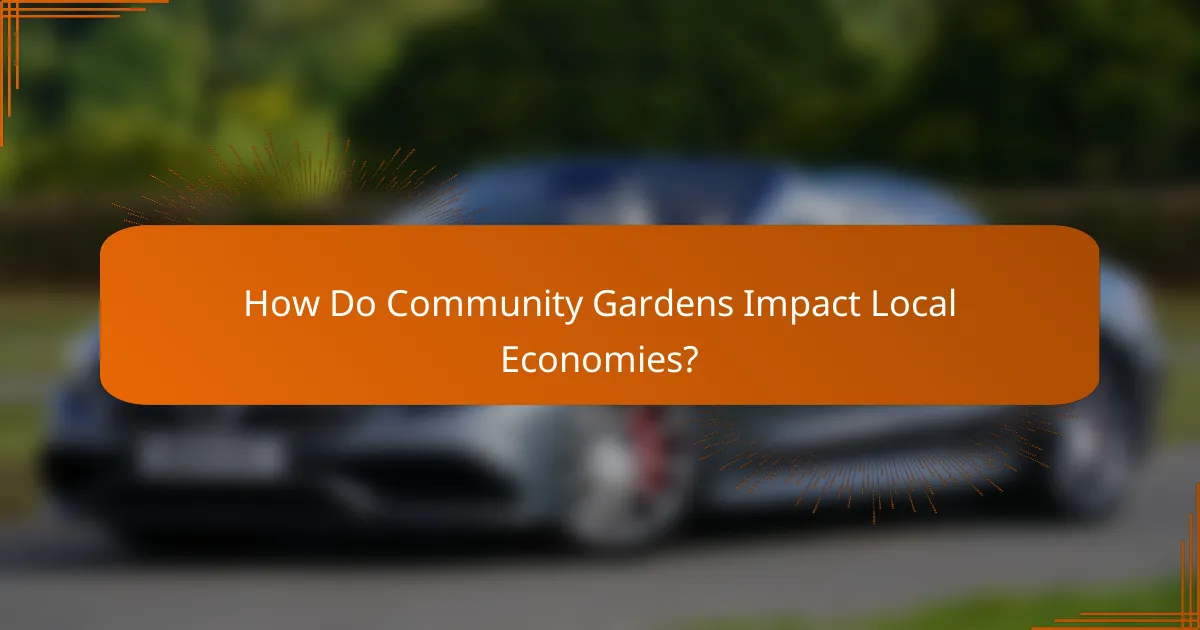
How Do Community Gardens Impact Local Economies?
Community gardens significantly boost local economies by creating jobs, increasing property values, and promoting local businesses. These gardens serve as hubs for economic activity, fostering community engagement and enhancing food security.
Creation of jobs
Community gardens contribute to job creation by providing employment opportunities in various roles, including garden management, landscaping, and educational programs. These positions often cater to local residents, helping to reduce unemployment rates in urban areas.
In addition to direct employment, community gardens can stimulate related job growth in sectors such as food production, distribution, and retail. For instance, local farmers’ markets may emerge, offering fresh produce and creating further job opportunities for vendors and artisans.
To maximize job creation, community gardens should consider partnerships with local organizations and businesses. This collaboration can lead to training programs and workshops that equip community members with skills necessary for employment in agriculture and food-related industries.
